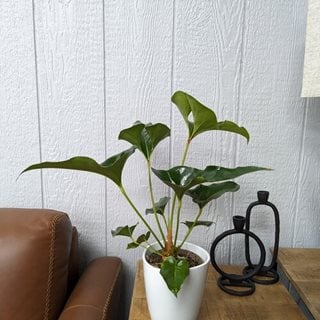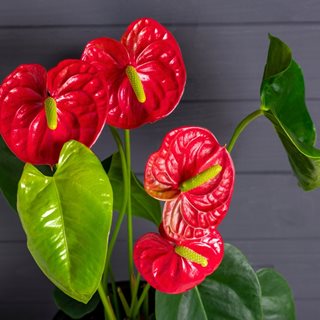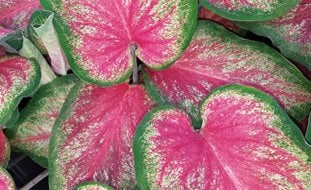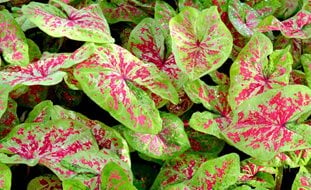A Guide to Growing and Caring for Anthurium Plants
Add a touch of the tropics to any indoor space with this beautiful flowering houseplant.
DocBlock® Michelle® (Anthurium hybrid). Photo by: Proven Winners
If you’re looking for an easy-care tropical houseplant with long-lasting flowers and striking foliage, Anthurium is one to check out. Commonly called flamingo flower, this trendy aroid is closely related to Spathiphyllum and Alocasia and shares features similar to both.
Many Anthurium are grown for their showy peace-lily-like flowers (or spathes), which come in white as well as vibrant shades of red, orange, purple, and pink. Other types of Anthurium forgo the flamboyant flowers and instead attract attention with their eye-catching veined leaves, which resemble those of an Alocasia.
No matter which type of anthurium you prefer, this unusual houseplant is a must for any indoor plant enthusiast and a great choice for beginners. When given the right growing conditions, including bright light and a warm and humid environment, anthuriums will thrive indoors with minimal effort. And with a little extra TLC, your flamingo flower will reward you with a stunning display of blooms for months on end.
On this page: Basics | Growing Tips | Care | Varieties | FAQs
On this page:
BASICS
Botanical name:
Anthurium spp. and hybrids
Common names:
Flamingo lily, laceleaf, painter’s palette, pigtail plant, tailflower, red peace lily
Origin:
Tropical regions of South America, Central America, and the Caribbean.
Growth rate:
Slow to moderate
Mature size:
12 to 24 inches tall and 9 to 12 inches wide
Foliage:
May be arrow-shaped, heart-shaped, or oblong, sometimes having wavy edges. The color is typically dark green, with some varieties featuring prominent veining. Leaf texture can vary too, ranging from smooth and glossy to soft and velvety.
Flowers:
Each bloom of Anthurium is actually a modified leaf bract, called a spathe, that surrounds a slender finger-like spadix covered densely with tiny true flowers. The spathes come in an array of colors, with red being the most common. The spadix is usually yellow but may also be pink, orange, or cream-colored.
Are anthurium plants toxic?
Yes! All parts of the plant contain calcium oxalate crystals that are toxic to dogs and cats. The sap can also irritate the skin and eyes. Keep out of reach of children and pets (see this guidance from the ASPCA), and always wear gloves when handling the plant.
GROWING ANTHURIUM PLANTS

Arching Amour™ Follow Your Heart™ (Anthurium brownii). Photo by: Proven Winners
Light:
Because flamingo flowers grow beneath a dense canopy of trees in their tropical rainforest environment, they will perform best in a location that receives bright but indirect or filtered sunlight for at least six hours a day. Near an east-facing window or several feet away from a west- or south-facing window is ideal, as long as you keep your plants out of direct sunlight, which can scorch the leaves. Although they will tolerate lower light conditions, they may stop blooming and growth will be stunted.
Temperature:
Anthurium love warmth and are most comfortable at room temperatures between 65° to 85° F. Keep plants away from cold drafts, and don’t expose them to temperatures below 60° F, which can damage the flowers and foliage. Also keep your plants away from heating or cooling vents, fans, and air conditioners.
Humidity:
Like most tropical plants, Anthurium flourish in humid environments and prefer humidity levels of 60% or higher, which can be a challenge to maintain indoors. One solution is to place your plants in a steamy, well-lit bathroom. In drier areas of the home, keep your plants hydrated by using a humidifier, misting the leaves regularly, or setting them on a tray filled with pebbles and water. If you notice that the leaves of your plant are turning brown and crispy, that’s often a sign that you need to boost the humidity. See more houseplants that thrive in high humidity.
Soil type:
In their native habitat, most flamingo flowers are epiphytes and can grow without soil in the crevices of trees. As houseplants, they do best when planted in a loose, well-draining potting mix rich in organic matter. A soilless aroid or orchid mix works well, or you can amend a regular all-purpose potting mix by adding orchid bark and perlite to improve drainage.
ANTHURIUM CARE

Flowering anthurium. Photo by: Marina Rich / Shutterstock
Watering:
Flamingo flowers are finicky about their water requirements and don’t like soil that’s either too dry or too wet. During the active growing season (spring through fall), water regularly to keep the soil evenly moist, or whenever the top inch of soil feels dry to the touch. During the winter, you can water less frequently, but don’t let the soil become bone dry. As you water, allow the excess to run through the drainage holes at the bottom of the pot, and discard any water in the saucer or tray beneath the container so your plant is not sitting in water.
Fertilizing:
Fertilize once a month during the growing season with an all-purpose plant food diluted to half strength to avoid burning the roots. Flowering types will benefit from the use of a fertilizer high in phosphorus, which will help to promote blooming. Cut back on the frequency of fertilization during the winter months.
Pruning:
To encourage new blooms and keep your anthuriums looking fresh and healthy, prune them as needed to remove any dead or yellowing foliage and spent flowers. Using clean, sharp pruning snips, make your cuts at the base of the stem instead of just removing the spathe. Be sure to wear gloves whenever you prune anthuriums because the sap can irritate the skin.
Leaf care:
Remove dust buildup from the leaves of your anthurium regularly by damp wiping them with a soft cloth. Not only will this keep them looking nice and vibrant, it will also improve their ability to absorb light.
Repotting:
Anthurium tend to be slow growers and can usually go for two to three years before they need to be moved to a larger pot. If you begin to see roots poking through the drainage holes at the bottom of the container, it’s time to repot to prevent your plant from becoming rootbound. Be sure to choose a new pot no more than 2 inches in diameter larger than the old one. Transplanting into a pot that’s too large can inhibit flowering because your plant will be focusing its energy on growing new roots.
Propagation:
By division (a good time to do this is when you repot) or by taking stem cuttings with two or three sets of leaves and rooting them in water.
Pests and diseases:
Keep an eye out for spider mites, mealybugs, scale, aphids, and fungus gnats. (See more on how to get rid of pests on houseplants.) Root rot can occur if anthuriums are overwatered or not planted in free-draining soil.
ANTHURIUM VARIETIES
See more Arching Amour™ anthurium plants in the leafjoy® line from Proven Winners.
FREQUENTLY ASKED QUESTIONS
Should I cut off dead anthurium flowers?
Yes. Snipping off wilted blooms will encourage your Anthuruim to produce new ones. On plants where the foliage is showier than the flowers, it’s a good idea to remove the blooms as soon as they form so more energy goes into the development of new leaves.
How do I get my anthurium to flower again?
It's normal for an Anthurium to have a rest period of a few months before it sends up new blooms. But if your plant hasn’t bloomed for some time, make sure you’re meeting its needs for plenty of bright light, warmth, and humidity. Feeding your plant with a high-phosphorus fertilizer can also help stimulate new flowers. If you can’t give your plants sufficient natural light, consider using grow lights as a supplement.
How often does an anthurium flower?
Anthurium can bloom intermittently year-round, with the flowers lasting two to three months on average. Under ideal conditions, it’s not uncommon for a plant to bloom three or four times over the course of a year.
Is Epsom salt good for anthurium plants?
Some houseplant growers swear by adding Epsom salt (magnesium sulfate) to the water for their anthuriums and other houseplants because it contains minerals that can enhance nutrient absorption and promote the growth of healthier, greener foliage. The Epsom Salt Council recommends using a dosage rate of 2 tablespoons of Epsom salt per gallon of water and feeding houseplants with the mixture monthly. Keep in mind that Epsom salt does not contain all the key nutrients an Anthurium needs for healthy growth, so it should never be used in place of a balanced fertilizer.
Why do the roots of my anthurium grow above the soil?
Those roots you see are aerial roots, which epiphytes use in nature to grab onto other plants and to absorb nutrients and humidity from the air. It’s best to leave the aerial roots in place because they can take in nutrients to supplement what your plant receives from the soil. To prevent the roots from drying out, cover them with a thin layer of sphagnum moss and mist regularly.
Can I grow anthurium outdoors?
In a warm, frost-free climate (zones 10 and above) Anthurium can be grown outdoors year-round in a spot shaded from direct sunlight. In colder areas, grow outdoors only during the summer months. Because they are very cold-sensitive, bring your plant indoors when temperatures begin to dip below 60° F.
















